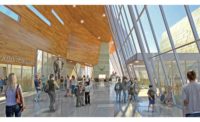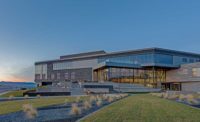SME Steel is based in an unassuming industrial area of West Jordan, Utah, about 15 miles southwest of Salt Lake City, but the company’s work appears in some of the most high-profile projects across the West.
From the new NFL stadiums in Los Angeles and the San Francisco Bay Area to large casinos in Las Vegas—and the unique hat truss that suspends 24 floors of a Class-A office space over an adjacent theater in Salt Lake City—SME has proven itself time and again as one of the region’s most dependable steel fabricators and erectors.
But SME, which posted regional revenue of $57 million in 2018, up from $56.6 million in 2017, rose from the ashes of misfortune. Swift Transportation trucking magnate Jerry Moyes formed the company after buying the assets of Salt Lake City’s bankrupt Stott Steel in 1992.
“When we started, we kind of already had two strikes against us because people in the industry identified us with the old company, so we had to earn back a lot of trust,” says Gordon Holladay, SME’s chief financial officer, who has been with the company since its founding.
SME Steel—short for Structural, Miscellaneous and Erection—has grown to become SME Industries, which is comprised of SME Steel Contractors, a fabrication and erection subsidiary headquartered in West Jordan, with additional fabrication facilities in Pocatello, Idaho, plus a newly opened shop in Price, Utah. The firm maintains erecting crews of about 500 ironworkers, says Dieter Klohn, president at SME Industries.
Southwest Steel, another subsidiary, has facilities in Henderson, Nev., and Phoenix and specializes in miscellaneous and specialty steel, stainless steel and bronze products such as handrails, staircases and custom ornamental work. CoreBrace and DuraFuse, located at the West Jordan headquarters, specialize in seismic stability products like buckling retrained braces. SME Logistics transports the company’s products.
SME Industries, which employs about 1,500 people, can fabricate and ship more than 2,000 tons of structural steel a week. Klohn says the company as a whole posted just under $500 million in overall revenue last year and is on target to meet or slightly exceed that number for 2019.
“Our people are the ones driving all that. Our strength is in our people from the office to the shop to the field,” Klohn says. “We are a company known for finishing things on time, for continuous innovation and improvement, and that is all from our people.”
The Business of Building
Holladay says company founder Moyes established new financial processes and worked hard to build SME’s reputation as a firm with solid business practices.
“We spent the first few years figuring out what [Stott Steel] didn’t know. There are reasons businesses fail. Stott knew steel, but they didn’t know how to run a business, and that’s what we started working on,” Holladay says. “Jerry is an incredible owner, and he supported us in those early years when we weren’t the prettiest girl at the dance.”
“We like to be involved [in a project] as early as possible.”
– Dieter Klohn, President, SME Industries
No place says rebuilding quite like Las Vegas, a city known for nearly constant renewal, and that’s where the new SME Steel began to rebuild. The company provided steel for the Stratosphere Hotel, then went on to supply the Caesars Palace Colosseum project, Showcase Mall and the Bellagio, among others. In Utah, the company landed projects including the Intermountain Medical Center, the Micron manufacturing plant in Lehi and the expansion of the Salt Palace Convention Center.
Another early project was AT&T Park (now Oracle Park) in San Francisco. The company also provided value-engineering services on the project. Being involved early in a project’s design was a tactic used by the company’s first executive vice president and co-founder, Craig Moyes, Jerry’s cousin.
“We are still doing this on large projects,” Klohn says. “We want to bring our expertise. We have people who can do design-assist, and we like to be involved as early as possible. It can help with overall performance on the project.”
Ron Dunn, chairman and principal at Salt Lake City-based structural engineering firm Dunn Associates Inc., has partnered with SME on multiple projects. “Our costs as a structural engineer are significantly less when SME is the provider, detailer and erector of our projects,” Dunn says. “We do difficult projects, and we need a top-shelf partner. SME is the perfect example of added value for a little more cost.”
Fred Strasser, a project manager at Salt Lake City-based Okland Construction, the general contractor on the 111 South Main office building, says early involvement by SME during development of the hat truss system was key to the success of the project. “They were brought on early to help with the constructibility of the hat truss and had some influence as the design was being developed,” Strasser says.
He recently worked with SME on renovations at the Vivint Smart Home arena, the home of the Utah Jazz and large-scale entertainment events. SME “jumped in and did all the miscellaneous steel. Some of it was very complicated as far as getting it rigged and installed. They were instrumental in the success of that project,” Strasser says.
Jared Francom, vice president of preconstruction for Okland, says he’s been impressed with SME’s reliability. “I’ve worked with them on several projects, and when they are involved, it just means things will be there when they are supposed to be and done the right way. It means the steel is one less thing I have to worry about.”
Gradual Growth
Holladay says the company has made strategic growth moves when opportunities have presented themselves. In the late 1990s, SME bought the operations of another bankrupt company in Las Vegas.
“They were contracted to produce all this beautiful, complicated work at new hotels in Las Vegas, but they were going broke,” he says. “We got things turned around and it fueled our casino work. Another company we bought was contracted to do huge marquee projects in California doing condos and hotels, but they were also going under. We bought them, and that was the birth of Southwest Steel.”
SME’s scope expanded again in 2001, when the Wallace F. Bennett Federal Building in Salt Lake City was retrofitted with buckling restrained braces.
“Those BRBs were being supplied by one company in Japan. We saw an emerging market and tried to come up with a better design,” Klohn says. “Through research and development, we came up with what we think is an improvement, and we filed for a number of patents. It’s a worldwide market, and we now have about 80% of that market.”
Klohn says the company recently saw a market opportunity for a moment-frame joint that provides seismic protection similar to the widely used SidePlate system. SME’s version, known as DuraFuse, was developed at Brigham Young University. He says it helps sustain buildings after a seismic event.
“In our system, you only remove and replace a single plate that takes the loads; with other systems, you would have to remove all the beams and columns after a seismic event,” Klohn says. “We bought the patent from BYU and started the company (DuraFuse) just over a year ago.”
Klohn and Holladay both see future growth coming from seismic stabilization products, not only in the Western U.S. but also in emerging countries in South and Central America as well as in the Pacific Rim.
Holladay says revenue from CoreBrace has steadily increased, and “we are expecting similar things from DuraFuse. Something like steel is seen as old and stodgy, but with these new technologies, we really feel like it is emerging as a very dynamic industry, and we feel we are on the leading edge of that,” he adds.








Post a comment to this article
Report Abusive Comment